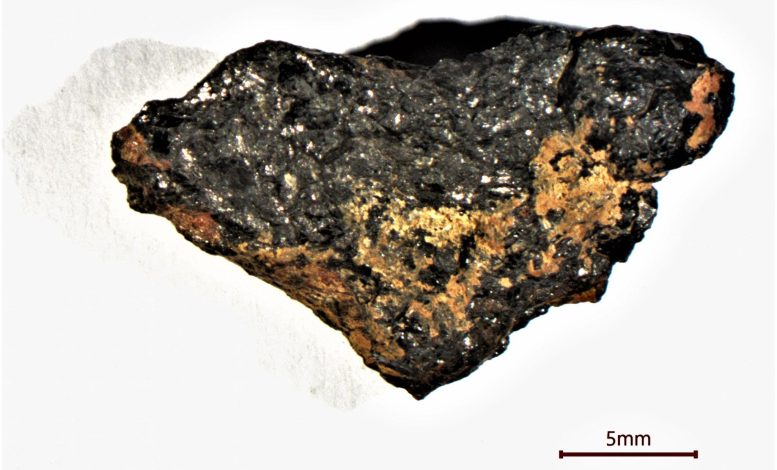
A 3-gram (0.1 ounce) sample of the Hypatia stone. Researchers found a consistent pattern of 15 elements in the Hypatia stone. The pattern is completely unlike anything in our solar system or our solar neighborhood, in the Milky Way. Credit: Romano Serra
New chemistry ‘forensics’ indicates that the stone named Hypatia from the Egyptian desert could be the first physical evidence found on Earth of a supernova type Ia explosion. These rare supernovas are some of the most energetic events in the universe.
This is the conclusion of a new research study by Jan Kramers, Georgy Belyanin, and Hartmut Winkler of the University of Johannesburg, and others that has been published in the journal Icarus.
Since 2013, Belyanin and Kramers have discovered a series of highly unusual chemistry clues in a small fragment of the Hypatia Stone.
In the new research, they meticulously eliminate ‘cosmic suspects’ for the origin of the stone in a painstaking process. They have pieced together a timeline stretching back to the early stages of the formation of Earth, our Sun, and the other planets in our solar system.
A cosmic timeline
Their hypothesis about Hypatia’s origin starts with a star: A red giant star collapsed into a white dwarf star. The collapse would have happened inside a gigantic dust cloud, also called a nebula.
That white dwarf found itself in a binary system with a second star. The white dwarf star eventually ‘ate’ the other star. At some point, the ‘hungry’ white dwarf exploded as a supernova type Ia inside the dust cloud.
After cooling, the gas atoms which remained of the supernova Ia started sticking to the particles of the dust cloud.
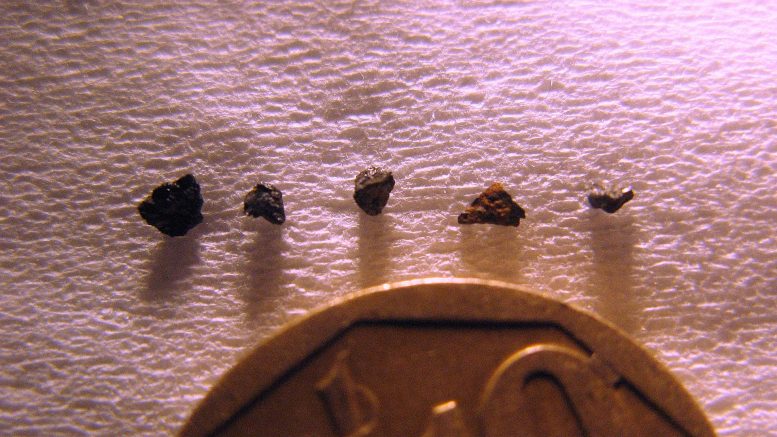
The tiny samples of the extraterrestrial Hypatia stone next to a small coin. Rare type Ia supernovas are some of the most energetic events in the universe. Researchers found a consistent pattern of 15 elements in the Hypatia stone. The pattern is completely unlike anything in our solar system or our solar neighborhood, the Milky Way. Prof Jan Kramers (University of Johannesburg) is the lead author. Credit: Jan Kramers
“In a sense we could say, we have ‘caught’ a supernova Ia explosion ‘in the act’, because the gas atoms from the explosion were caught in the surrounding dust cloud, which eventually formed Hypatia’s parent body,” says Kramers.
A huge ‘bubble’ of this supernova dust-and-gas-atoms mix never interacted with other dust clouds.
Millions of years would pass, and eventually the ‘bubble’ would slowly become solid, in a ‘cosmic dust bunny’ kind of way. Hypatia’s ‘parent body’ would become a solid rock sometime in the early stages of formation of our solar system.
This process probably happened in a cold, uneventful outer part of our solar system – in the Oort cloud or in the Kuiper belt.
At some point, Hypatia’s parent rock started hurtling towards Earth. The heat of entry into the earth’s atmosphere, combined with the pressure of impact in the Great Sand Sea in southwestern Egypt, created micro-diamonds and shattered the parent rock.
The Hypatia stone picked up in the desert must be one of many fragments of the original impactor.
The Hypatia stone could be the first tangible evidence on Earth of a supernova Type Ia explosion. Supernovas of the type Ia are rare — and some of the most energetic events in the universe. UJ researchers found a consistent pattern of 15 elements in the Hypatia stone discovered in Egypt. The pattern is completely unlike anything in our solar system or our solar neighborhood in the Milky Way. But most of the elements match the pattern of supernova type Ia models. Prof Jan Kramers (University of Johannesburg) is the lead author. Credit: Therese van Wyk
“If this hypothesis is correct, the Hypatia stone would be the first tangible evidence on Earth of a supernova type Ia explosion. Perhaps equally important, it shows that an individual anomalous ‘parcel’ of dust from outer space could actually be incorporated in the solar nebula that our solar system was formed from, without being fully mixed in,” says Kramers.
“This goes against the conventional view that dust which our solar system was formed from, was thoroughly mixed.”
Three million volts for a tiny sample
To piece together the timeline of how Hypatia may have formed, the researchers used several techniques to analyze the strange stone.
In 2013, a study of the argon isotopes showed the rock was not formed on Earth. It had to be extraterrestrial. A 2015 study of noble gases in the fragment indicated that it may not be from any known type of meteorite or comet.
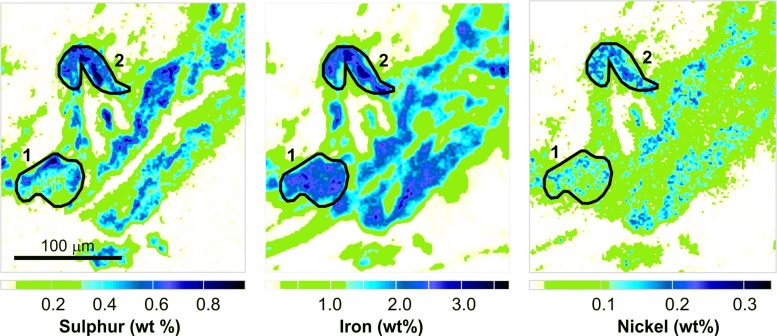
A high-voltage proton beam shows three trace elements in the extraterrestrial Hypatia stone, and their concentrations. Here, we see sulfur, iron, and nickel for targets 1 and 2 within region 14 on the sample. Dr Georgy Belyanin (University of Johannesburg) used a 3-million Volt proton beam to analyze the tiny fragment of the stone. Credit: Georgy Belyanin
In 2018 the UJ team published various analyses, which included the discovery of a mineral, nickel phosphide, not previously found in any object in our solar system.
At that stage Hypatia was proving difficult to analyze further. The trace metals Kramers and Belyanin were looking for, couldn’t really be ‘seen in detail’ with the equipment they had. They needed a more powerful instrument that would not destroy the tiny sample.
Kramers started analyzing a dataset that Belyanin had created a few years before.
In 2015, Belyanin had done a series of analyses on a proton beam at the iThemba Labs in Somerset West. At the time, Dr. Wojciech Przybylowicz kept the three-million Volt machine humming along.
In search of a pattern
“Rather than exploring all the incredible anomalies Hypatia presents, we wanted to explore if there is an underlying unity. We wanted to see if there is some kind of consistent chemical pattern in the stone,” says Kramers.
Belyanin carefully selected 17 targets on the tiny sample for analysis. All were chosen to be well away from the earthly minerals that had formed in the cracks of the original rock after its impact in the desert.
“We identified 15 different elements in Hypatia with much greater precision and accuracy, with the proton microprobe. This gave us the chemical ‘ingredients’ we needed, so Jan could start the next process of analyzing all the data,” says Belyanin.
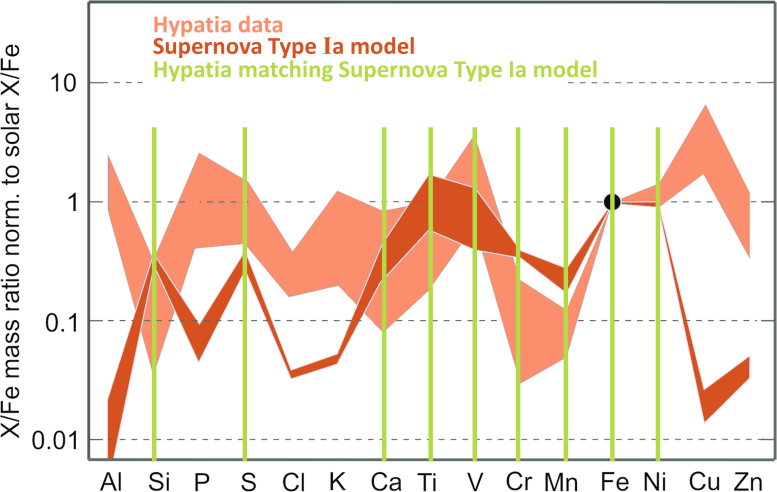
UJ researchers find that most of the elements they analyzed in the extraterrestrial Hypatia stone fit the predictions from supernova Ia models well. The high-voltage proton beam data shows that for 9 of the 15 elements, concentrations are close to the predicted values. Prof Jan Kramers (University of Johannesburg) is the lead author. Credit: Jan Kramers
Proton beam also rules out solar system
The first big new clue from the proton beam analyses was the surprisingly low level of silicon in the Hypatia stone targets. The silicon, along with chromium and manganese, were less than 1% to be expected for something formed within our inner solar system.
Further, high iron, high sulfur, high phosphorus, high copper, and high vanadium were conspicuous and anomalous, adds Kramers.
“We found a consistent pattern of trace element abundances that is completely different from anything in the solar system, primitive or evolved. Objects in the asteroid belt and meteors don’t match this either. So next we looked outside the solar system,” says Kramers.
Various analyses of the Hypatia stone in Egypt indicate that it was not formed on Earth or inside our solar system. A new study shows it may have preserved an unusual chemical pattern similar to that from a supernova Ia explosion. Dr. Georgy Belyanin (University of Johannesburg) used a 3-million Volt proton beam to analyze a tiny fragment of the stone. Credit: Therese van Wyk
Not from our neighborhood
Then Kramers compared the Hypatia element concentration pattern with what one would expect to see in the dust between stars in our solar arm of the Milky Way galaxy.
“We looked to see if the pattern we get from average interstellar dust in our arm of the Milky Way galaxy fits what we see in Hypatia. Again, there was no similarity at all,” adds Kramers.
At this point, the proton beam data had also ruled out four ‘suspects’ of where Hypatia could have formed.
Hypatia did not form on Earth, was not part of any known type of comet or meteorite, did not form from average inner solar system dust, and not from average interstellar dust either.
Not a red giant
The next simplest possible explanation for the element concentration pattern in Hypatia would be a red giant star. Red giant stars are common in the universe.
But the proton beam data ruled out mass outflow from a red giant star too: Hypatia had too much iron, too little silicon, and too low concentrations of heavy elements heavier than iron.
Nor a supernova Type II
The next ‘suspect’ to consider was a supernova type II. Supernovas of type II cook up a lot of iron. They are also a relatively common type of supernova.
Again, the proton beam data for Hypatia ruled out a promising suspect with ‘chemistry forensics’. A supernova type II was highly unlikely as the source of strange minerals like nickel phosphide in the pebble. There was also too much iron in Hypatia compared to silicon and calcium.
It was time to closely examine the predicted chemistry of one of the most dramatic explosions in the universe.
Heavy metal factory
A rarer kind of supernova also makes a lot of iron. Supernovas of the type Ia only happen once or twice per galaxy per century. But they manufacture most of the iron (Fe) in the universe. Most of the steel on earth was once the element iron created by Ia supernovas.
Also, established science says that some Ia supernovas leave very distinctive ‘forensic chemistry’ clues behind. This is because of the way some Ia supernovas are set up.
First, a red giant star at the end of its life collapses into a very dense white dwarf star. White dwarf stars are usually incredibly stable for very long periods and most unlikely to explode. However, there are exceptions to this.
A white dwarf star could start ‘pulling’ matter off another star in a binary system. One can say the white dwarf star ‘eats up’ its companion star. Eventually, the white dwarf gets so heavy, hot, and unstable, that it explodes in a supernova Ia.
The nuclear fusion during the supernova Ia explosion should create highly unusual element concentration patterns, as accepted scientific theoretical models predict.
Also, the white dwarf star that explodes in a supernova Ia is not just blown to bits, but literally blown to atoms. The supernova Ia matter is delivered into space as gas atoms.
In an extensive literature search of star data and model results, the team could not identify any similar or better chemical fit for the Hypatia stone than a specific set of supernova Ia models.
Forensic elements evidence
“All supernova Ia data and theoretical models show much higher proportions of iron compared to silicon and calcium than supernova II models,” says Kramers.
“In this respect, the proton beam laboratory data on Hypatia fit to supernova Ia data and models.”
Altogether, eight of the 15 elements analyzed conform to the predicted ranges of proportions relative to iron. Those are the elements silicon, sulfur, calcium, titanium, vanadium, chromium, manganese, iron, and nickel.
Not all 15 of the analyzed elements in Hypatia fit the predictions though. In six of the 15 elements, proportions were between 10 and 100 times higher than the ranges predicted by theoretical models for supernovas of type 1A. These are the elements aluminum, phosphorus, chlorine, potassium, copper, and zinc.
“Since a white dwarf star is formed from a dying red giant, Hypatia could have inherited these element proportions for the six elements from a red giant star. This phenomenon has been observed in white dwarf stars in other research,” adds Kramers.
If this hypothesis is correct, the Hypatia stone would be the first tangible evidence on Earth of a supernova type Ia explosion, one of the most energetic events in the universe.
The Hypatia stone would be a clue of a cosmic story started during the early formation of our solar system, and be found many years later in a remote desert strewn with other pebbles.
Reference: “The chemistry of the extraterrestrial carbonaceous stone “Hypatia”: A perspective on dust heterogeneity in interstellar space” by Jan D. Kramers, Georgy A. Belyanin, Wojciech J. Przybylowicz, Hartmut Winkler and Marco A. G. Andreoli, 22 April 2022, Icarus.
DOI: 10.1016/j.icarus.2022.115043

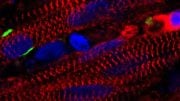

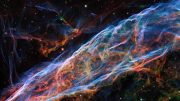

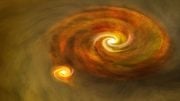



How did this Hypatia stone come to be collected and identified in the first place? Was the location pinpointed at the time of collection? Would there not be a likelihood of additional material to examine in its proximity, or must it be considered as an entirely unique and complete object?